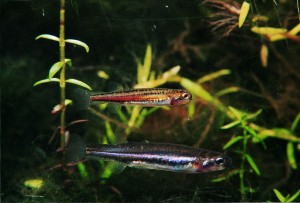Conservation review of the nationally vulnerable Dwarf Galaxias (Galaxiella pusilla) in the South East of South Australia
The Dwarf Galaxias (Galaxiella pusilla) is a tiny freshwater fish endemic to south-eastern Australia, where it occurs in Tasmania, South Australia and Victoria. The species is listed as Vulnerable under the Australian Government Environment Protection and Biodiversity Conservation Act 1999. It has a unique ecology occurring in shallow and often seasonal wetlands, where it is thought to survive short term habitat drying by surviving in Swamp Yabby burrows.
The Dwarf Galaxias is still widely distributed, but populations are fragmented and patchy across the landscape; a trend that, in the South East of South Australia, has been induced by artificial drainage of the region’s formerly extensive wetlands. Hence, it is likely that the species has suffered a significant decline in abundance due to habitat changes to shallow freshwater wetlands. This decline appears to be continuing, as several previously recorded populations have become extinct in recent decades, and further declines have been observed between 2001 and 2008, during a period of prolonged below average rainfall in the region. Extant (green) and likely extirpated (red) population status identified during the 2008 conservation asssessment (conducted by Michael Hammer) during the grip of drought, are shown in the map below, .
However, the past two years have provided above-average rainfall across much of the species range in the South East, leading to a potential increase in condition and extent of available habitat for the species. A recently received grant from Nature Foundation SA will allow an review of the response of the Dwarf Galaxias to the recent above average rainfall period by examining the status and, if present, relative abundance and recruitment index of the species at key sites across the Lower South East. Three categories of key sites will be sampled as part of the survey (where presumed extinct or was experiencing severe declines in 2008; stronghold populations; other potentially suitable locations, where no previous surveys have been undertaken) to provide a comprenhensive coverage across the SE range of the species.
Special thanks to Nature Foundation SA for making this project possible.
- Under the surface – the latest round of aquatic fauna assessments in the Wannon River wetlands 21/01/2021
- What do dwarf galaxias, orchids and woodland birds have in common? 23/07/2016
- Permanent pools along the Wannon River provide critical refuge through the tough times 28/06/2016
- Some great local stories in edition 27 of Wetlands Australia magazine 14/08/2015
- A fresh look at the Dwarf Galaxias – or ‘Lap-lap’ (in Boandik language) – one of our region’s smallest native freshwater fish 12/03/2015
- Dwarf Galaxias report released 05/06/2014
- The search for Dwarf Galaxias continues in the South East 21/11/2013
- Dwarf Galaxias Project Page Up and Running 06/10/2012
- First Grants Awarded to NGT 09/04/2012



